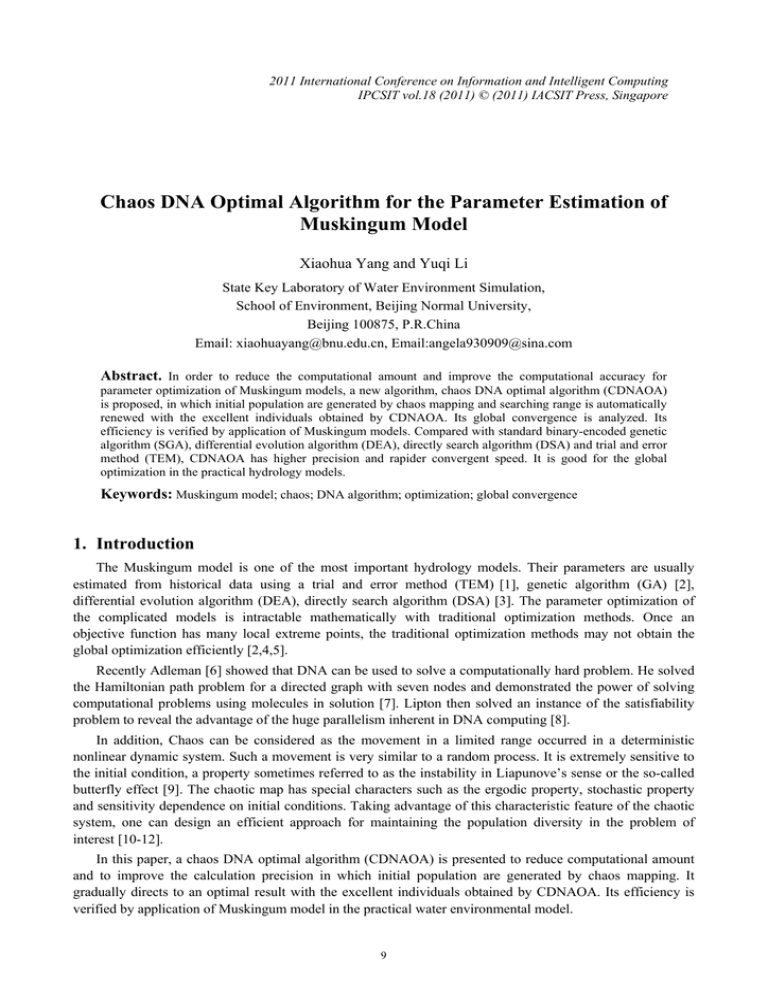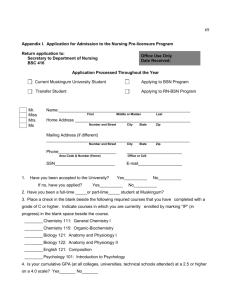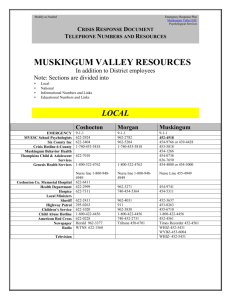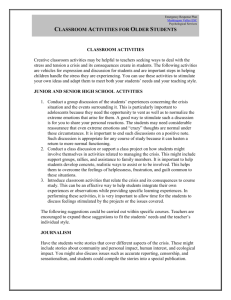Chaos DNA Optimal Algorithm for the Parameter Estimation of Muskingum Model
advertisement

2011 International Conference on Information and Intelligent Computing
IPCSIT vol.18 (2011) © (2011) IACSIT Press, Singapore
Chaos DNA Optimal Algorithm for the Parameter Estimation of
Muskingum Model
Xiaohua Yang and Yuqi Li
State Key Laboratory of Water Environment Simulation,
School of Environment, Beijing Normal University,
Beijing 100875, P.R.China
Email: xiaohuayang@bnu.edu.cn, Email:angela930909@sina.com
Abstract. In order to reduce the computational amount and improve the computational accuracy for
parameter optimization of Muskingum models, a new algorithm, chaos DNA optimal algorithm (CDNAOA)
is proposed, in which initial population are generated by chaos mapping and searching range is automatically
renewed with the excellent individuals obtained by CDNAOA. Its global convergence is analyzed. Its
efficiency is verified by application of Muskingum models. Compared with standard binary-encoded genetic
algorithm (SGA), differential evolution algorithm (DEA), directly search algorithm (DSA) and trial and error
method (TEM), CDNAOA has higher precision and rapider convergent speed. It is good for the global
optimization in the practical hydrology models.
Keywords: Muskingum model; chaos; DNA algorithm; optimization; global convergence
1. Introduction
The Muskingum model is one of the most important hydrology models. Their parameters are usually
estimated from historical data using a trial and error method (TEM) [1], genetic algorithm (GA) [2],
differential evolution algorithm (DEA), directly search algorithm (DSA) [3]. The parameter optimization of
the complicated models is intractable mathematically with traditional optimization methods. Once an
objective function has many local extreme points, the traditional optimization methods may not obtain the
global optimization efficiently [2,4,5].
Recently Adleman [6] showed that DNA can be used to solve a computationally hard problem. He solved
the Hamiltonian path problem for a directed graph with seven nodes and demonstrated the power of solving
computational problems using molecules in solution [7]. Lipton then solved an instance of the satisfiability
problem to reveal the advantage of the huge parallelism inherent in DNA computing [8].
In addition, Chaos can be considered as the movement in a limited range occurred in a deterministic
nonlinear dynamic system. Such a movement is very similar to a random process. It is extremely sensitive to
the initial condition, a property sometimes referred to as the instability in Liapunove’s sense or the so-called
butterfly effect [9]. The chaotic map has special characters such as the ergodic property, stochastic property
and sensitivity dependence on initial conditions. Taking advantage of this characteristic feature of the chaotic
system, one can design an efficient approach for maintaining the population diversity in the problem of
interest [10-12].
In this paper, a chaos DNA optimal algorithm (CDNAOA) is presented to reduce computational amount
and to improve the calculation precision in which initial population are generated by chaos mapping. It
gradually directs to an optimal result with the excellent individuals obtained by CDNAOA. Its efficiency is
verified by application of Muskingum model in the practical water environmental model.
9
2. Muskingum models
The flow conditions at two locations on a river can be related through the continuity equation.
,
(1)
dW
= I −Q
dt
. W = kQ ' = k ( xI + (1 − x )Q )
(2)
In which I and Q represent the inflow and outflow discharges to the river reach at the two locations,
respectively, W represents the storage volume within the reach, k and x are the Muskingum parameters, and t
is time. The continuity equation can be expressed in finite difference form as:
(3)
~
Q(1) = Q(1)
~
~
Q (i ) = c1 I (i ) + c 2 I (i − 1) + c3 Q (i − 1), i = 2,..., n
.
c1 + c 2 + c3 = 1
~
(4)
(5)
In which Q(i ) and Q(i ) represent the calculated outflow discharges and observed outflow discharges at
time t, respectively. I (i) represents the inflow discharge at time interval t i . n is the total time number,
c1 , c 2 and c3 are the Muskingum parameters in (4).
In order to estimate the parameters of the above Muskingum models, we adopt the following objective
function:
min f (c1, c2 )
n
~
= (∑| c1I (i) + c2 I (i −1) + (1− c1 − c2 )Q(i −1) −Q(i) |) /(n −1)
(6)
i=2
3. Description of Cdnaoa
Consider the following optimization problem:
min f (c1 , c 2 ,⋅ ⋅ ⋅, c p )
{
}
st.. a j ≤ c j ≤ b j , for j=1,2,…, p
(7)
where c = c j , j = 1,2,..., p , c j is a parameter to be optimized, f is an objective function and f ≥ 0 .
The procedure of CDNAOA is shown as follows.
Step 1 (DNA encoding). Suppose DNA encoding length is m in every parameter, the jth parameter range
is the interval [a j , b j ] , and then each interval is divided into 2 m − 1 sub- intervals:
(8)
c = a + θ ⋅ (2 m − 1) ⋅ h
j
j
j
j
where the length of sub- interval of the jth parameter h j =
bj − a j
2m −1
is constant. The searching location
I j = θ j ⋅ (2 m − 1) , is an integer, and 0 ≤ I j < 2 m , θ j is a chaos variable, 0 ≤ θ j ≤ 1 ,for j = 1,2,..., p .
The DNA code array of the jth parameter is denoted by the grid points of {d ( j , k ) | k = 1,2,..., m} for
every individual:
.
m
I j = ∑ d ( j, k ) ⋅ 2 k −1
(9)
where ⊕ denotes the operator of addition modulo 2 on {0,1} . CDNAOA’s process operates on a population
of individuals (also called DNA code array, strings or chromosomes). Each individual represents a potential
solution to the problem. For corresponding 1× 1 → T , 1× 0 → A, 0 × 1 → G, 0 × 0 → C. The first position value ‘1’
or ‘0’ expresses the position of DNA code and the second position value ‘1’ or ‘0’ expresses the true value of
binary code, and the value of DNA code.
k =1
Step 2 (Creating the initial population by chaos algorithm). To cover the whole solution space and to
avoid individuals entering into the same region, large uniformity random population is selected in this
algorithm. The initial population of n chromosomes is generated by chaos algorithm. We give chaos variable
θ j as follows:
x( j , k , i ) = 1 − a ⋅ x( j , k , i − 1) 2 + b ⋅ x ( j , k , i − 2)
10
(10)
x( j , k , i ) − x min
(11)
, i = 1,2,..., n
x max − x min
where θ ( j, k , i) are chaos controlling variables of Henonmap system, where x min is the minimum of
x( j, k , i) and x max is the maximum of x( j, k , i) . Here we let a = 1.41, b = 0.34 and θ ( j , k ,−1) = 0.95 ,
θ ( j , k ,0) =0.23, i =1,2,…,300. When a = 1.4, b = 0.3 , phase points will full in the phase space and system
(10)-(11) will be chaos [9]. Once the initial father population has been generated, the decoding and fitness
evaluation should be done.
θ ( j, k , i) =
Step 3 (Evaluating fitness value of each individual). The smaller the value f (i) is, the higher the fitness of
its corresponding ith chromosome is. So the fitness function of ith chromosome is defined as follows:
1
F (i ) =
[ f (i )]2 + 1.0
Step 4 (Selection). Select chromosome pairs randomly depending on their fitness value from the initial
population. And two groups of n -chromosomes d1 ( j , k , i), d 2 ( j , k , i ) , are gotten
( j = 1,2,..., p; k = 1,2,..., m; i = 1,2,..., n ).
Step 5 (Two-point crossover and two-point mutation). Perform crossover and mutation on chromosomes
the same as GA in Fig. 1and Fig. 2 as follows:
…AAGAT|CCGTCGGA|CAGAG… (Chromosome 1)
…CTGAT|AAGTCAGA|TATAG… (Chromosome 2)
Point 1
Point 2
…AAGAT| AAGTCAGA |CAGAG…
…CTGAT| CCGTCGGA |TATAG…
Figure 1.
Flow chart describing the CDNAOA for two-point crossover
…AAGAT|AAGTCGGA|CAGAG…(Chromosome)
Point 1
Point 2
…AAGAT|TTGTCAGT|CAGAG…
Figure 2.
Flow chart describing the CDNAOA for two-point mutation
Step 6 (DNA evolution). Repeat Steps 3 ~6 until the evolution times q = Q (Q is the total evolution times)
or the termination condition is satisfied.
Step 7 (Optimal accelerating cycle). The parameter ranges of ne -excellent individuals (the ne individuals
nearest to the optimum solution in the evolution) obtained by Q-times of the DNA-encoded optimal evolution
alternating are regarded as the new ranges of the parameters, and then the whole process back to the DNAencoding. The CDNAOA computation is over until the algorithm running times gets to the design T times or
there exists an optimal chromosome C fit whose fitness satisfies a given criterion. In the former case the C fit is
the fittest chromosome or the most excellent chromosome in the population. The chromosome C fit represents
the solution.
The CDNAOA is convergent if the shrinking interval ratio k tj ≤ α <1, ∀t , j = 1,2,..., p [13]. Considering
the evolution generations Q, excellent individuals ne , optimized parameter p and accelerating evolution
generations T, the probability pe of excellent individuals surround the optimum point is pe = (1 − 2 Qne ) pT [13].
And the CDNAOA is global convergence with probability pe =1.000 000, and ne =10, Q≥3. From the above
analysis, we can conclude that the global optimization of the CDNAOA is not only accurate but also stable.
11
In this paper the parameters of the CDNAOA are selected as follows: The length e =10, population size
n=100, the number of excellent individuals ne =10, the times of evolution alternating Q=3, the crossover
probability pc = 1.0 , and the mutation probability p m =0.5.
4. Practical Example
Example. An automatic calibration for the Muskingum models.
The Parameter estimation of Muskingum models is studied in this paper. Time interval Δt = 12h . The
observed inflow and outflow discharges for the practical example are shown in Fig. 3. The detail data can be
seen in [3].
Figure 3.
The figure of the observed inflow discharges I and outflow discharges Q
The parameters c1 and c2 are required in this model. The significance of these parameters can be seen in
(4)-(6). In this work, these two parameters are estimated with respect to one criterion, namely the mean
absolute error. The form of the objective function is described in (6).
The optimal parameters c1=0.1159, c2=0.7174, the mean absolute error f is 45.84 with CDNAOA. For
CDNAOA, the evaluation number of the objective function is 900. The computational results of the above
model are given in Table 1. For SGA (Standard binary-encoded genetic algorithm), the evaluation number of
the objective function is 2400, and the mean absolute error f is 52.59. For DEA (Differential evolution
algorithm) [3], the evaluation number of the objective function is 2400, and the mean absolute error f is 47.98.
For DSA (Directly search algorithm) [3], the mean absolute error sum f is 49.55. And for TEM (Trial and
error method), the mean absolute error f is 52.84.
Table 1 gives the errors comparison of several methods. From Table 1, we can see that the results
achieved with our CDNAOA are satisfactory in global optimum and convergent speed. In terms of
minimizing the objective function, CDNAOA has shown to be capable for Muskingum models.
TABLE I.
COMPARISON WITH SEVERAL METHODS IN THE MUSKINGUM MODELS
Parameters
Methods
CDNAOA
SGA
DEA
DSA
TEM
The
evaluation
number
900
2400
2400
-
c1
0.1159
0.0151
0.1269
0.2310
0.1175
c2
0.7174
0.8699
0.7296
0.5380
0.7554
Mean
absolute
errors
f
45.84
52.59
47.98
49.55
52.84
5. Conclusion
In this paper, the chaos DNA optimal algorithm (CDNAOA) is developed for the parameter optimization
of Muskingum models. The circulating mechanism of CDNAOA has been studied. The corresponding global
convergent ability is analyzed for the new CDNAOA. The global optimization of the CDNAOA is not only
accurate but also stable. Because the DNA-encoding, the chaos initial population and accelerating cycle are
adopted, the efficiency and accuracy of the new CDNAOA algorithm are very high compared with SGA,
DEA, DSA and TEM methods. It has been applied to the Muskingum models, and the results are encouraging.
This paper provides a good optimal algorithm for the parameter estimation of the practical hydrology models.
12
6. Acknowledgment
This work was supported by the National Basic Research Program of China (No. 2010CB951104), the
Project of National Natural Science Foundation of China (No. 50939001, 51079004), the Specialized
Research Fund for the Doctoral Tutor Program of Higher Education (No. 20100003110024), and the Program
for Changjiang Scholars and Innovative Research Team in University (No.IRT0809).
7. References
[1] H.J. Chu, “The Muskingum Flood Routing Model using a Neuro-Fuzzy Approach,” KSCE Journal of Civil
Engineering, vol. 13, May 2009, pp. 371-376, doi:10.1007/s12205-009-0371-6.
[2] S. Mohan, “Parameter estimation of nonlinear Muskingum models using genetic algorithm,” Journal of Hydraulic
Engineering, ASCE, vol. 123,Feb.1997, pp. 137-142, doi:10.1061/(ASCE)0733-9429.
[3] X.J.Xu and X.X.Zhong, “Differential Evolution for Parameter Estimation of Muskingum Model,” Complex
Systems and Complexity Science, vol. 5, Mar. 2008, pp. 85-91.
[4] J.Yoon and G.Padmanabhan, “Parameter estimation of linear and nonlinear Muskingum Routing Models,” J. Water
Resour. Planning Mgmt, vol. 119,May 1993, pp. 600-610, doi:10.1061/(ASCE)0733-9496.
[5] X.H.Yang, Z.F.Yang, and Z.Y.Shen, “GHHAGA for Environmental Systems Optimization,” Journal of
Environmental Informatics, vol. 5, Jan. 2005, pp. 36-41, doi:10.3808/jei.200500044.
[6] L.Adleman, “Molecular computation of solutions to combinatorial problems,” Science, vol. 266, Nov. 1994, pp.
1021-1024, doi:10.1126/science.7973651.
[7] C.W. Yeh, C.P Chu, and K.R.Wu, “Molecular solutions to the binary integer programming problem based on DNA
computation,” Biosystems, vol.83, May 2006, pp. 56-66, doi:10.1016/j.biosystems.2005.09.005.
[8] R.J.Lipton, “DNA Solution of hard computational problems,” Science, vol. 268, Apr. 1995, pp. 542-545,
doi:10.1126/science.7725098.
[9] E.N.Lorenz, “Deterministic non-periodic flows,” Jat Mos Sci., vol.20, Feb. 1963, pp. 130-141, doi:10.1175/15200469.
[10] Q.Z.Lu, G.L.Shen, and R.Q.Yu, “A chaotic approach to maintain the population diversity of genetic algorithm in
network training,” Computational Biology and Chemistry, vol. 27, Feb. 2003, pp. 363-371, doi:10.1016/S14769271(02)00083-X.
[11] X.H.Yang, Z.F.Yang, X.A.Yin, and J.Q. Li, “Chaos gray-coded genetic algorithm and its application for pollution
source identifications in convection–diffusion equation,” Communications in Nonlinear Science and Numerical
Simulation, vol. 13, Aug. 2008, pp. 1676-1688, doi:10.1016/j.cnsns.2007.03.003.
[12] B. Liu, L.Wang, and Y.H. Jin. “Improved particle swarm optimization combined with chaos,” Chaos,Solitons and
Fractals, vol.25, May 2005, pp. 1261-1271, doi:10.1016/j.chaos.2004.11.095.
[13] X.H.Yang, Z.F.Yang G.H.Lu, and JQ.Li, “A Gray-encoded, hybrid-accelerated, genetic algorithm for global
optimizations in dynamical systems,” Communications in Nonlinear Science and Numerical Simulation, vol. 10,
Apr. 2005, pp. 355-363, doi:10.1016/j.cnsns.2003.12.005.
13






